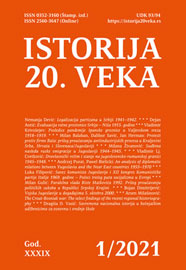LEGALIZACIJA PARTIZANA U SRBIJI 1941‒1942.
LEGALIZATION OF PARTISANS IN SERBIA 1941-1942
Author(s): Nemanja DevićSubject(s): Military history, Political history, Recent History (1900 till today), WW II and following years (1940 - 1949)
Published by: Institut za savremenu istoriju, Beograd
Keywords: 1941;Serbia;Uprising;Partisans;Communist Party of Yugoslavia;Civil War;Legalization;
Summary/Abstract: The collapse of the uprising in Serbia in the fall and winter of 1941 also opened the question of the fate of the guerrillas, members of the resistance movement who did not leave Serbia with their leaders. Most of them, especially the members of the partisan movement, found themselves under repression by the occupation and collaborationist authorities. Some of the insurgents remained on the ground and tried to save themselves by joining the military organization of the Serbian Government. Some of them did this spontaneously, but others started infiltrating on the orders of their superiors. Members of Colonel Mihai-lović’s Chetnik detachments began legalization on their own in November of 1941 and later with the approval of their commander; several thousand people remained in the ranks of the Serbian State Guard or in the Chetnik detachments of Kosta Pećanac until the spring of 1943. Some of them were involved in re-pressive acts against members of the rival partisan movement. On the other hand, some members and officers from the ranks of the NOP joined the collabo-rationist units, although to a much lesser extent. From February 1942, they also infiltrated [the collaborationist units] on the instructions of the Provincial Committee of the CPY for Serbia, in order to get weapons, equipment and in-formation from the enemy. The phenomenon of partisan legalization was not local – it happened throughout Serbia and included several hundred former fighters, sometimes leaders and members of the CPY, who used their position to deal with the nationalist forces. This process was not discussed in historiograph-ical works and syntheses about the partisan movement, although partisan mem-oirs and a number of preserved documents speak about it precisely. Although less prevalent in relation to the competing resistance movement in terms of characteristics, degree of cooperation, and general mass, the legalization of partisans remained one of the dark spots in the history of the partisan movement in Serbia, and also one of the examples of its “Machiavellian” strategy.
Journal: Istorija 20. veka
- Issue Year: 2021
- Issue No: 1
- Page Range: 1-18
- Page Count: 18
- Language: Serbian

